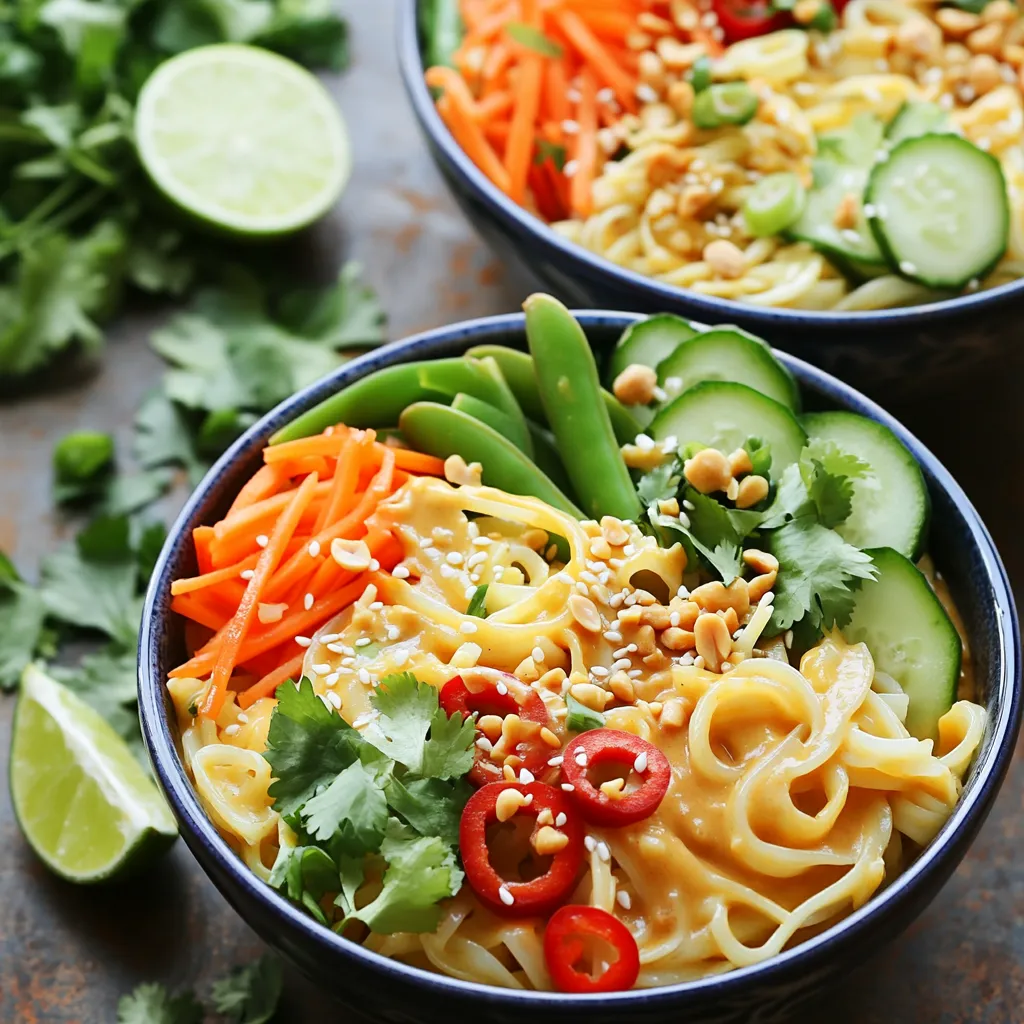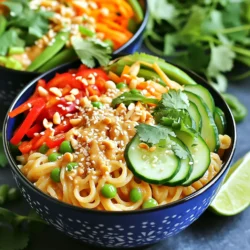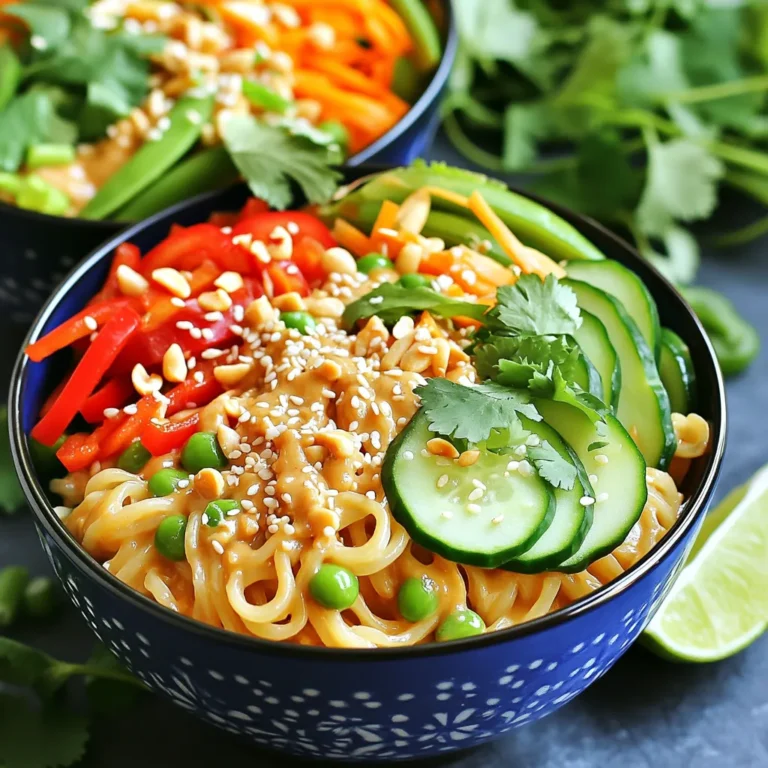Craving a quick and tasty dinner? Look no further than this Thai Peanut Noodles recipe! It’s packed with flavor, fun to make, and perfect for any night of the week. I’ll guide you through easy steps to create a delicious dish with simple ingredients. From creamy peanut sauce to crunchy veggies, you’ll love every bite. Let’s get started on this flavorful adventure!
Ingredients
Complete List of Ingredients for Thai Peanut Noodles
To make Thai peanut noodles, gather these simple ingredients:
– 8 oz rice noodles
– 1 cup snap peas, trimmed
– 1 red bell pepper, thinly sliced
– 1 carrot, julienned
– 1 cucumber, julienned
– 3 green onions, chopped
– 1/4 cup cilantro, chopped
– 1/2 cup creamy peanut butter
– 1/4 cup low-sodium soy sauce
– 2 tablespoons lime juice
– 1 tablespoon honey or maple syrup
– 1 tablespoon sesame oil
– 1 teaspoon ginger, minced
– 1 clove garlic, minced
– Crushed peanuts and sesame seeds for garnish
Substitutions and Alternatives
You can switch some ingredients based on your taste or what you have at home. For rice noodles, try whole wheat noodles or even zucchini noodles for a low-carb option. If you don’t like snap peas, use green beans or bell peppers. You can swap peanut butter for almond butter or sunbutter if you need nut-free. For soy sauce, tamari works well for gluten-free diets.
Optional Garnishes for Serving
Garnishes can add fun and flavor! Consider these options:
– Crushed peanuts for crunch
– Sesame seeds for extra flavor
– Fresh lime wedges for a tangy kick
– Extra cilantro for a fresh touch
These garnishes make your dish pop and taste even better!
Step-by-Step Instructions
Cooking the Rice Noodles
To start, grab a large pot and fill it with water. Add a pinch of salt. Bring the water to a boil. Once boiling, add 8 oz of rice noodles. Cook them as the package says, usually around 5 to 7 minutes. We want them soft but not mushy. Drain the noodles in a colander. Rinse them under cold water to stop the cooking. This keeps them from sticking together. Set the noodles aside for later.
Preparing the Peanut Sauce
Next, let’s make the sauce. In a mixing bowl, add 1/2 cup of creamy peanut butter. Pour in 1/4 cup of low-sodium soy sauce and 2 tablespoons of lime juice. Then, add 1 tablespoon of honey or maple syrup. Drizzle in 1 tablespoon of sesame oil. Don’t forget 1 teaspoon of minced ginger and 1 clove of minced garlic. Whisk everything together until smooth. If the sauce feels too thick, add a tablespoon of warm water. This will help it blend better.
Sautéing the Vegetables
Now, heat a large skillet over medium heat. Add a splash of water or a bit of sesame oil. Toss in 1 cup of trimmed snap peas, 1 thinly sliced red bell pepper, and 1 julienned carrot. Sauté these for 3 to 4 minutes. You want them tender but still crisp. The colors should pop, making the dish look fresh and lively.
Combining Noodles and Sauce
It’s time to bring everything together. Add your cooked rice noodles to the skillet with the sautéed veggies. Pour the peanut sauce over the top. Toss everything gently, so the noodles and veggies get coated in the sauce. This should take about 1 to 2 minutes.
Adding Fresh Ingredients
Once mixed, remove the skillet from the heat. Stir in freshly chopped cucumber, green onions, and cilantro. This adds crunch and a burst of flavor. Mix well so everything is combined.
Serving Suggestions
Now, it’s time to serve. Divide the Thai peanut noodles into bowls. For extra flair, sprinkle crushed peanuts and sesame seeds on top. If you want, add a lime wedge on the side. This gives a fresh kick that brightens the dish. Enjoy your colorful and tasty meal!
Tips & Tricks
How to Make Noodles Less Sticky
To keep your noodles from sticking, rinse them well. After cooking, drain them and run cold water over them. This cools the noodles and stops the cooking process. You can also toss them with a bit of sesame oil. This adds flavor and keeps them separate.
Adjusting Spiciness Levels
If you want your dish to be spicier, add chili paste or red pepper flakes. Start small and taste as you go. You can also use fresh chili peppers for a bold kick. If you prefer milder flavors, skip the heat or add a little extra honey to balance it out.
Enhancing Flavor with Fresh Herbs
Fresh herbs can take your dish to the next level. Add chopped cilantro and green onions right before serving. These herbs add a bright taste and a nice crunch. You can also use mint or basil for a unique twist. Feel free to mix and match based on what you have on hand!

Variations
Adding Proteins (Chicken, Tofu, Shrimp)
You can boost your Thai peanut noodles with protein. Chicken, tofu, or shrimp all work well. For chicken, use boneless and skinless breasts. Cook them in the skillet until golden. For tofu, press and cube it before cooking. Sauté until crispy. For shrimp, cook until pink and opaque. Add your protein during the combine step. This adds flavor and makes the meal filling.
Vegetarian & Vegan Adaptations
To make this dish vegetarian or vegan, simply skip the meat. Use tofu or tempeh as your protein. Both options give great texture. Ensure your peanut butter and soy sauce are vegan-friendly. You might also add more veggies like bell peppers and broccoli. They add color and crunch. This way, you keep the dish tasty and satisfying.
Gluten-Free Options
If you need a gluten-free meal, choose gluten-free soy sauce. Many brands offer it. Also, ensure your rice noodles are gluten-free. Most rice noodles fit this bill. To enhance flavors, add lime juice and fresh herbs. You’ll still get that rich taste without gluten. Enjoy this dish without worry!
Storage Info
How to Store Leftovers
To keep your Thai peanut noodles fresh, place them in an airtight container. Make sure they cool down before sealing. Store them in the fridge for up to three days. This way, you can enjoy them later without losing flavor.
Reheating Instructions
When you’re ready to eat, reheat the noodles in a skillet over low heat. Add a splash of water or a bit of peanut sauce to keep them moist. Stir gently for about five minutes until they are heated through. You can also use the microwave. Place them in a microwave-safe bowl and cover it. Heat in short bursts, stirring in between, until warm.
Freezing Tips
If you want to save some for later, you can freeze the noodles. Divide them into portions and place them in freezer bags. Remove as much air as you can before sealing. These can last in the freezer for about a month. To eat, thaw them overnight in the fridge. Then, reheat as mentioned above.
FAQs
What can I substitute for peanut butter?
If you need a peanut butter substitute, try almond butter or sunflower seed butter. Both options work well in this recipe. They provide a similar texture and flavor. If you want a nut-free option, sunflower seed butter is the best choice.
How to make Thai peanut noodles spicier?
To add heat, mix in red pepper flakes or sriracha sauce. Start with a little and taste as you go. You can also use fresh chili peppers for a more intense spice. Adjust the heat to match your taste.
Are Thai peanut noodles gluten-free?
Thai peanut noodles can be gluten-free if you use gluten-free soy sauce. Regular soy sauce contains wheat. Always check labels to ensure the ingredients are gluten-free. Rice noodles are naturally gluten-free, making them a great base.
How long do Thai peanut noodles last in the fridge?
Thai peanut noodles last about 3 to 5 days in the fridge. Store them in an airtight container. When you’re ready to eat, just reheat them in a skillet or microwave.
Can I make this recipe in advance?
Yes! You can make this recipe ahead of time. Just store the noodles and sauce separately. This keeps the noodles from getting soggy. Mix them just before serving for the best taste.
What dishes pair well with Thai peanut noodles?
Thai peanut noodles pair nicely with spring rolls or a fresh salad. You could also serve them with grilled chicken for added protein. These options balance the rich peanut flavor well.
In this blog post, we explored how to make Thai peanut noodles. We covered all the ingredients, including alternatives and garnishes. I shared step-by-step instructions, from cooking noodles to combining them with sauce. You learned tips to make your noodles flavorful and less sticky. We also discussed variations, storage, and common FAQs.
Thai peanut noodles are easy to customize and delicious. Enjoy making this dish your own!


